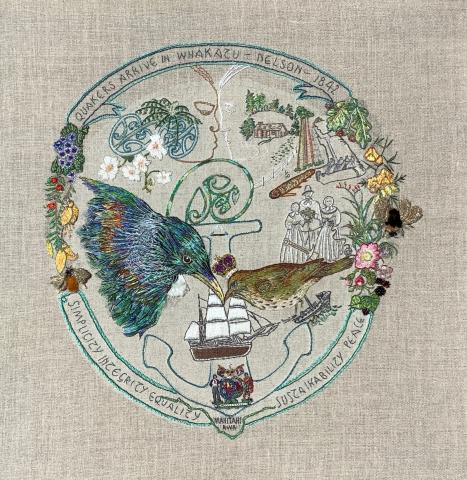Quakers in Nelson Embroidery can now be viewed online
The Nelson Quaker Embroidery sets out to tell the history of Nelson (Whakatū) Friends (Quakers), from its beginnings in seventeenth-century England to the present day. It is in the form of a series of rounded embroidery images, or roundels. Roundels 1 and 2 tell of the insight of George Fox that there is "that of God" in each person. It shows Swarthmore Hall, where Margaret Fell gave Friends their earliest home.
Roundel 2 refers to Fox's preaching on Pendle Hill in Lancashire in 1652, which drew a crowd of followers.
Roundel 3 is the most detailed, and tells the complex story of Quakers' arrival in Nelson as part of European settlement in the 1840s, and their relationship with Māori. The design deliberately contrasts indigenous and introduced elements. Points of tension are shown by the inclusion of the surveying instrument: a reference to the Quaker surveyor John Cotterell who was killed in the Wairau conflict in 1843. The New Zealand Company employed a number of Quaker surveyors, including Cotterell, and put them in an invidious position by its dishonest land practices.
The Nelson Quaker Embroidery began in a conversation between two members of Nelson Meeting: Lizi McLeod-Taepa, and Patricia Morrisey. Each brought their particular skills: Lizi as artist and designer, and Patricia as embroiderer. Lizi carried out detailed research on the history, and brought her deep interest in the Māori response to colonial settlement and efforts to find peace. In her design she wished to respect and acknowledge the truth of our bicultural history. Patricia completed the last roundel just days before her death.
You can see and read more about the Embroidery at quakers-in-nelson.org.nz/quaker-histories-in-embroidery. By hovering the cursor over each roundel the multiple stories depicted in each roundel are available to view.

